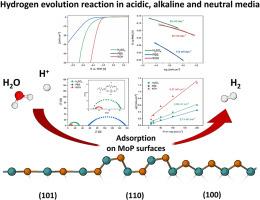不同介质下磷化钼催化析氢反应机理的研究
IF 7.9
3区 材料科学
Q1 GREEN & SUSTAINABLE SCIENCE & TECHNOLOGY
引用次数: 0
摘要
水的电化学分解由于其过程的纯度和可再生性,是一种有效的绿色制氢方法。氢气的产生是通过析氢反应(HER)进行的,使用适当的催化剂可以促进该过程。过渡金属磷化物(TMPs),特别是MoP,有可能取代昂贵的pt基催化剂。然而,大多数研究都是实验研究,没有进行DFT模拟,并且没有详细描述该过程的机制。因此,本研究旨在研究MoP催化剂在所有pH范围内对HER的催化性能和反应机理,并将电化学分析与模拟相结合,以获得更深入的机理见解。用实验合成的MoP样品在酸性、碱性和中性介质中研究了具有(101)、(110)和(100)面的MoP表面。MoP催化剂在碱性介质中表现出优异的HER活性,电荷转移阻力(Rct)为7.12 Ω。DFT结果还表明,MoP(101)和MoP(110)的吸附能(ΔEad)分别为- 0.93 eV和- 1.21 eV,较好地吸附了H2O。在实验和DFT结果的基础上,提出了一种考虑不同介质和不同MoP方面的HER机制。本文章由计算机程序翻译,如有差异,请以英文原文为准。

A study of the mechanism of the hydrogen evolution reaction catalysed by molybdenum phosphide in different media
The electrochemical decomposition of water is an effective method of green hydrogen production due to the purity and renewability of the process. The production of hydrogen occurs through the hydrogen evolution reaction (HER), and the process may be facilitated by using proper catalysts. Transition metal phosphides (TMPs), especially MoP, can potentially replace expensive Pt-based catalysts. However, most studies deal with experimental research without DFT simulations, and the process's mechanism is not described in detail. Therefore, this study aims to investigate the catalytic performance and reaction mechanism of an MoP catalyst for HER across all pH ranges and combine electrochemical analysis with simulations to gain deeper mechanistic insights. MoP surfaces with (101), (110) and (100) facets are prepared and investigated with experimentally synthesised MoP samples studied in acidic, alkaline, and neutral media. MoP catalyst exhibits superior HER activity in an alkaline media with charge transfer resistance (Rct) of 7.12 Ω. DFT results also showed that H2O adsorption is preferred on MoP(101) and MoP(110) with adsorption energy (ΔEad) of −0.93 eV and −1.21 eV, respectively. Based on experimental and DFT results, a proposed HER mechanism considers various MoP facets and different media.
求助全文
通过发布文献求助,成功后即可免费获取论文全文。
去求助
来源期刊

Materials Today Sustainability
Multiple-
CiteScore
5.80
自引率
6.40%
发文量
174
审稿时长
32 days
期刊介绍:
Materials Today Sustainability is a multi-disciplinary journal covering all aspects of sustainability through materials science.
With a rapidly increasing population with growing demands, materials science has emerged as a critical discipline toward protecting of the environment and ensuring the long term survival of future generations.
 求助内容:
求助内容: 应助结果提醒方式:
应助结果提醒方式:


